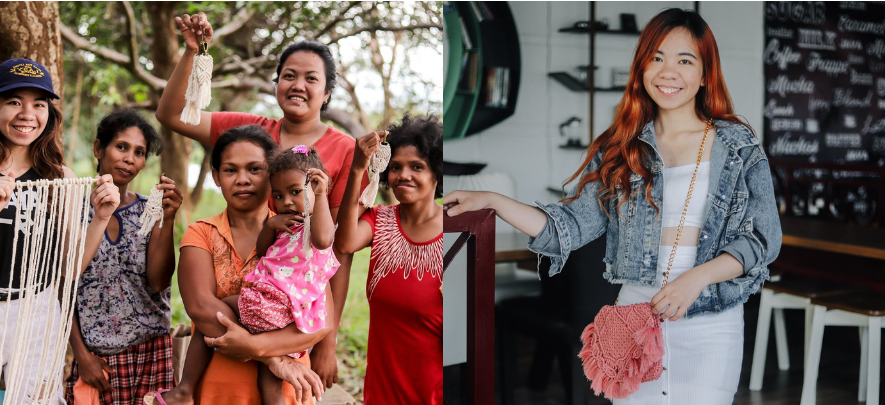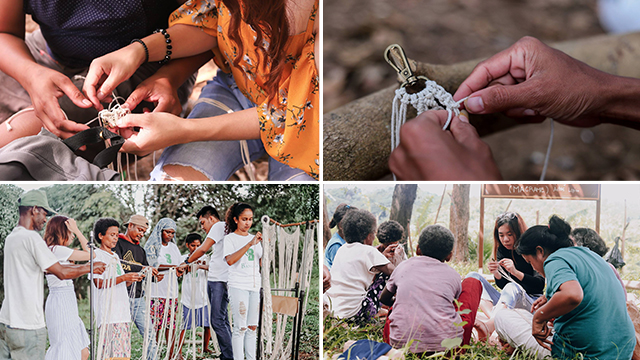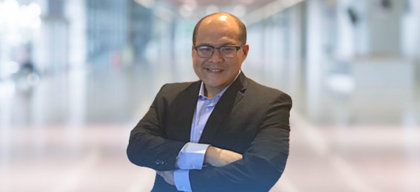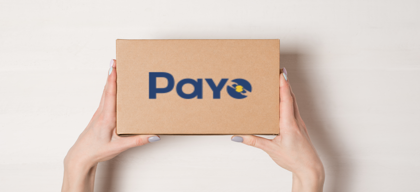This engineer turned social entrepreneur co-creates social impact with the indigenous people of Ayta Magbukun in Bataan

SME Inspirations
275 week ago — 8 min read
Enterprise: Impact Living
Founder: Camay Villeroz
Industry: General stores
Year it was founded: 2018
Location: Bangkal, Bataan
Seeing the lack of opportunities and how marginalized the indigenous people of Ayta Magbukun in Bangkal, Bataan were, Camay Villeroz, founder of Impact Living, couldn’t help but do something.
It started as a series of immersion, where Camay along with her friends, had the desire to help the community. They launched several community projects in partnership with other companies to provide school supplies and basic needs of the community. However, Camay soon realized that donation drive activities are not sustainable and are not enough to help the community.
Moved by the situation, she founded Impact Living to empower the Ayta community and help them become self-sufficient. Impact Living produces viable and sustainable products such as bamboo straws, macramé arts, crafts, and honey.
While she could have chosen to work her way up the corporate ladder as a mechanical engineer, Camay chose to follow the inner voice that led her to do meaningful work where she can make an impact in the lives of other people. “The community has become part of my life, they have become like my second family,” she shares.
Social entrepreneurship isn’t easy, but when you see its impact on the community, everything is worth it.
In conversation with GlobalLinker (GL), Camay Villeroz (CV) shares how her desire to help other people led her to build and co-create Impact Living with the Ayta Community. She also shares some of her rewarding and unforgettable experience working in the grassroots, and what she has learned from her social entrepreneurship journey.
GL: How did you discover the AETA community in Bangkal, Bataan?
CV: I started going there when I was in college. We initiated several community projects for the AETA community including Project Litratu, where we’ve given over 120 school ID and partnered with other companies like San Miguel and Max’s. It’s a collective effort and it ran for a year. We used to visit the community every month, and that’s when I fell in love with the community. Although, I realized that the donations that we were doing weren’t sustainable.

GL: You mentioned you realized that donations aren’t sustainable. How did you move forward and later on create a social enterprise for the community?
CV: I encountered the idea of social entrepreneurship in 2015 from the event I attended in DOST (Department of Science and Technology). I told myself that I want to be a social entrepreneur someday. But I forgot that desire when I started working in the corporate world.
But because, I started working on the grounds in Bangkal, that’s where the desire of becoming of social entrepreneur was awakened again. But at that time, I didn’t know what kind of social enterprise that I wanted to start. All I knew is that I want to do this for the community, and it’s not going to be another donation type of activity. We want to innovate their skills and tap their potential.
GL: Take us back to how Project Bangkal, now Impact Living started.
CV: We collected the abundant resources that are available in Bangkal and we connected it to their skills. First, there is a lot of bamboo in the community, so we created products out of bamboo. We created coin banks, but its value is quite low, so we ventured into other products. We tried bamboo straws also, and then we noticed a particular skill – they are fond of braiding. So somehow we thought that perhaps we can maximize their skills in braiding. That’s how we started integrating macramé in our program.
GL: What are the challenges of running a social enterprise?
CV: First, financials. Back then when I started Impact Living, I resigned from my job. I resigned in April of 2018, and we started our training for the community in September 2018. I shelled out all my savings in 2018 to build the enterprise. The next challenge was how to engage them in our skills training. We started our training by just inviting them to join. There are 15 mothers who came for our first training, but by the next training, it went down to 3.
We noticed that there’s something wrong with the training that we are doing. But what we did is that we focused our energy on the three mothers who stayed. We trained them and we were eventually able to grow. In the next workshop, we no longer had a hard time inviting mothers because the three mothers helped us to tap other mothers who were interested to join. There are a lot of challenges before you can scale your business. As of now, we still have a lot of challenges.
GL: What have you learned from your social enterprise journey?
CV: I realized that the solution is already grounded in the community. If you’re running a social enterprise, find someone from your community who can supervise if you’re not around because that’s where they will feel that they are being empowered.
Running a social enterprise is difficult, but if you will just give up, how about the momentum that you have built for your community? If you will give up, what will happen to them? How about them?
GL: What keeps you going in running your social enterprise?
CV: Impact living has become part of my life. The community has become part of my life, they have become like my second family. Honestly, I also don’t know why I’m not giving up, what I only know is that I should never quit.
GL: What have you discovered about yourself doing this?
CV: I discovered that I can develop a community, but I can’t do it alone. You can organize or develop a community only if you co-create the enterprise with them.
Also read: 4 things I've learned from running a social enterprise
GL: What are your tips for aspiring social entrepreneurs?
CV: Be true to your advocacy. It’s going to be difficult if you’re just going to do it for profit. Social entrepreneurship isn’t easy, but when you see its impact on the community, everything is worth it. Don’t give up, because the entire community is at stake if you do that.

GL: How do you keep your passion alive?
CV: Always go back to your community. Never allow that you’re not visiting them even once a month. When you immerse yourself with the community, you will feel that you’re part of the community even if you’re not an Indigenous People (IP). Also, it’s fulfilling to see them grow.
Also read: Focus on your passion and it can become your business
GL: What has changed from the time you started to now in your community?
CV: Their self-confidence has improved. There was an incident when we praised their output. We were surprised that they cried. They cried in joy because according to them it was their first time that someone showered praises on them.
GL: What can you say to people who say that indigenous people are difficult to train?
CV: A lot of people have told me about it that it will take time for me to train them. What I learned is that when you train them, don’t impose solutions. Allow your community to be creative so they can enjoy what they are doing. It’s a matter of organizing them.
To explore business opportunities, link with Camay Villeroz by clicking on the 'Connect' button on her profile.
Disclaimer: This article is based solely on the inputs shared by the featured member. GlobalLinker does not necessarily endorse the views, opinions & facts stated by the members
Network with SMEs mentioned in this article
View GlobalLinker 's profile
SME Inspirations
Most read this week
Trending











Comments
Share this content
Please login or Register to join the discussion